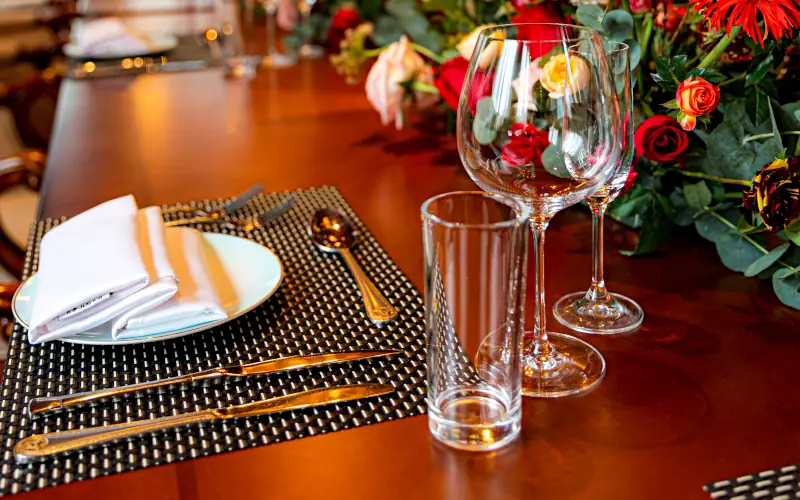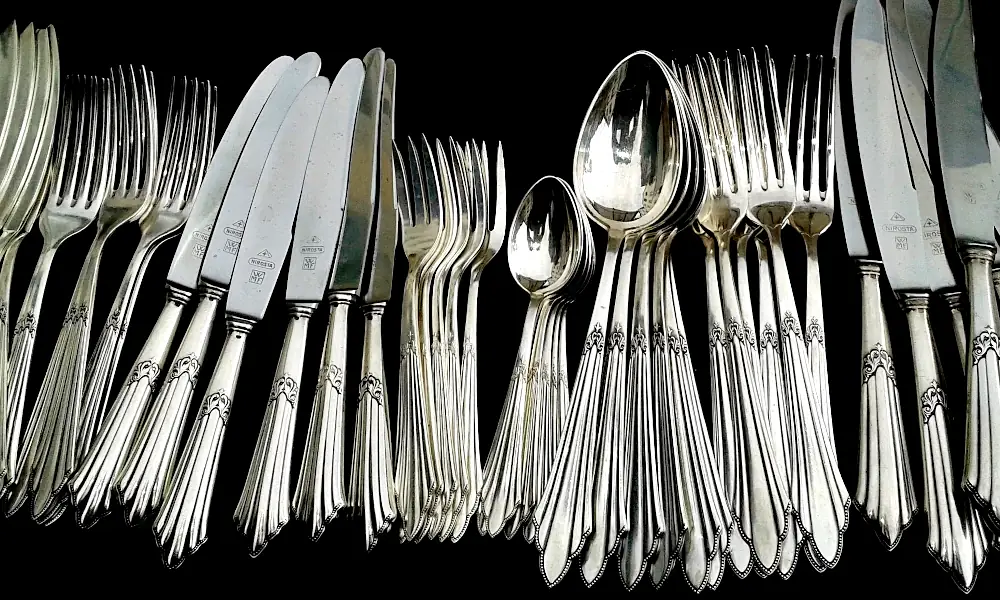Silverware etiquette may seem like a small detail, but in formal dining and fine restaurants, your utensil use and placement speak volumes about your manners. Knowing how to place your knife and fork, signal a finished meal, or navigate multi-course settings can make any dining experience more polished and comfortable.
Table of Contents
- What Is Silverware Etiquette?
- Understanding Dining Silverware Placement
- Fine Dining Silverware Placement Rules
- Silverware and Napkin Placement
- Continental Silverware Etiquette vs. American Style
- Tips for Silverware Etiquette
- Did You Know About Silverware Etiquette?
- Frequently Asked Questions About Silverware Etiquette
- What is silverware etiquette?
- How do I signal I’m done eating?
- What’s the difference between silverware and cutlery?
- What is continental silverware etiquette?
- Where should I place my napkin during the meal?
- Is it rude to start eating before everyone is served?
- How do I use multiple forks and knives at a formal dinner?
- Conclusion
What Is Silverware Etiquette?
Silverware etiquette refers to the proper use, handling, and placement of cutlery during a meal. It includes when and how to use each utensil, as well as what your silverware communicates to the host or server.
Following proper dining silverware etiquette helps you avoid awkward missteps and shows respect for your dining companions.
Understanding Dining Silverware Placement
The way your utensils are arranged at a table and how you position them during and after the meal can convey specific messages.
Basic Dining Silverware Placement
| Utensil | Placement |
|---|---|
| Fork | Left of the plate |
| Knife | Right of the plate (blade facing inward) |
| Spoon | Right of the knife |
| Dessert Spoon/Fork | Above the dinner plate |
| Napkin | On the plate or to the left of the fork |

Etiquette Silverware Placement Signals
| Utensil Position | Meaning |
|---|---|
| Fork and knife in an “X” shape | Pause or still eating |
| Fork and knife parallel at 4:20 | Finished with your meal |
In cutlery etiquette finished meal signals, placing utensils together at the 4:20 clock position (fork tines up, knife blade in) is the standard way to indicate you’re done.
Fine Dining Silverware Placement Rules
Formal meals often involve multiple courses, and silverware is placed accordingly. Always work from the outside in:
- First Course (Appetizer): Use the outermost fork and knife.
- Main Course: Use the innermost utensils closest to the plate.
- Dessert: Use utensils placed above the plate or brought later.
Proper fine dining silverware placement enhances the flow of service and helps you keep pace with the meal.
Silverware and Napkin Placement
While the focus is often on forks and knives, silverware and napkin placement are both part of the etiquette equation:
- Unfold your napkin and place it on your lap after sitting.
- If leaving the table temporarily, place the napkin loosely on your chair.
- At the end of the meal, fold the napkin and place it to the left of your plate.
Continental Silverware Etiquette vs. American Style
There are two main styles of using silverware: Continental and American.
| Feature | Continental Style | American Style |
|---|---|---|
| Knife hand | Right | Right |
| Fork hand | Left | Left (cut) → Right (eat) |
| Eating style | Tines down, no switching hands | Tines up, switch fork to right to eat |
| Common in | Europe | North America |
Continental silverware etiquette favors efficiency, while American style reflects older traditions of grace and control.
Tips for Silverware Etiquette
5 Tips for Silverware Etiquette
- Don’t point with utensils or gesture while holding them.
- Avoid resting silverware on the table mid-meal—use the plate edge.
- Use serving utensils for shared dishes, never your own fork.
- Don’t lick or scrape silverware noisily.
- Wait to eat until everyone has been served and the host begins.
These silverware manners ensure a pleasant experience for everyone at the table.
Did You Know About Silverware Etiquette?
- The placement signal for “I am finished” comes from 19th-century European court dining traditions.
- Dining silverware etiquette was once used to distinguish social classes in both Europe and early America.
- In some royal households, using the wrong fork for a course could mark you as uncultured.
- The term cutlery is more common in the UK, while silverware is more common in the US—even when it’s not made of silver.
Frequently Asked Questions About Silverware Etiquette
What is silverware etiquette?
Silverware etiquette refers to the proper use, handling, and placement of forks, knives, and spoons during a meal. It includes both how you use them and how you place them when eating or finished.
How do I signal I’m done eating?
Place your fork and knife parallel to each other at the 4:20 position on your plate. This universal signal indicates a finished meal.
What’s the difference between silverware and cutlery?
They refer to the same thing—eating utensils. “Cutlery” is more common in British English, while “silverware” is used in American English.
What is continental silverware etiquette?
Continental etiquette involves keeping the fork in the left hand and the knife in the right throughout the meal, without switching hands.
Where should I place my napkin during the meal?
Place it on your lap after sitting. If you leave the table briefly, set it on your chair. At the end of the meal, place it to the left of your plate.
Is it rude to start eating before everyone is served?
Yes, in formal settings, it’s proper to wait until everyone is served and the host begins eating.
How do I use multiple forks and knives at a formal dinner?
Start from the outermost utensils and work inward with each course.
Conclusion
Mastering silverware etiquette not only shows that you respect those around you but also helps you feel more confident at formal events and dinners. From dining silverware placement to continental silverware etiquette, understanding these small but significant rules can elevate your dining presence.
Whether you’re attending a business lunch or a wedding reception, polished silverware manners are always in style.
Explore more table manners in our Dining category.

